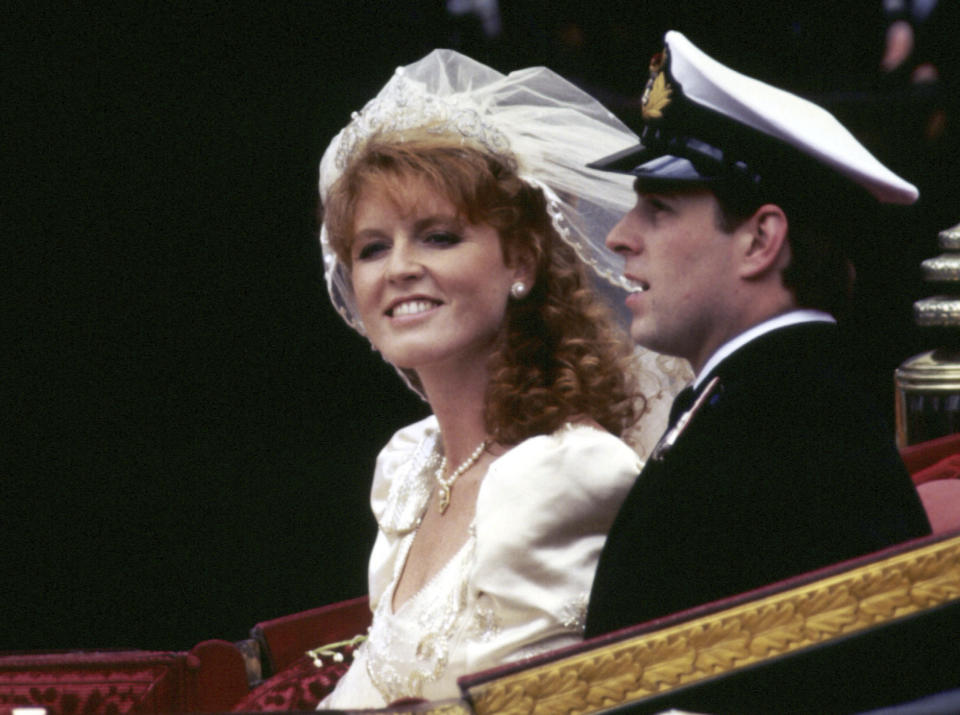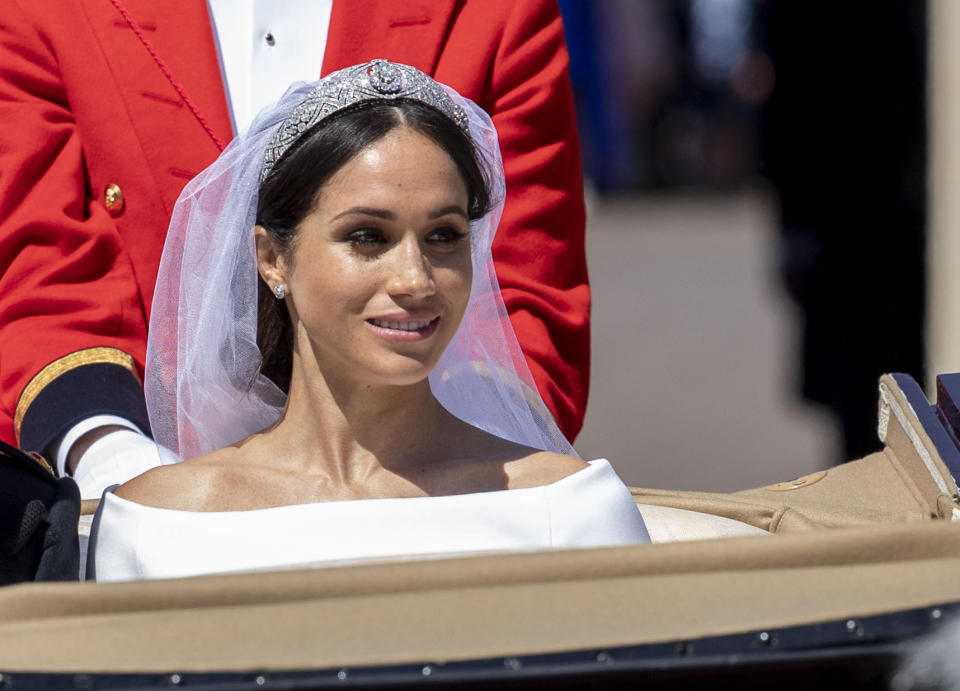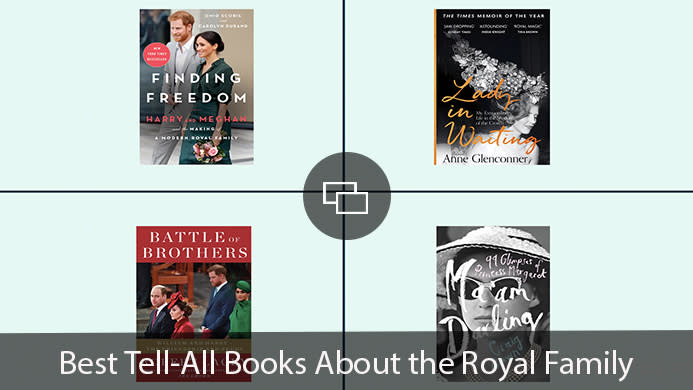Meghan Markle & Sarah ‘Fergie’ Ferguson’s Royal Rejections Had One Big Difference

- Oops!Something went wrong.Please try again later.
- Oops!Something went wrong.Please try again later.
- Oops!Something went wrong.Please try again later.
- Oops!Something went wrong.Please try again later.
Content Warning: This article contains mentions of suicide and suicidal ideation.
It’s been decades since Sarah Ferguson, Duchess of York had to deal with the tidal wave of tabloid scrutiny she faced during her marriage to Prince Andrew, Queen Elizabeth II’s second son. As the Duchess formerly known as “Fergie” reflects today on her time as a part of “The Firm” while promoting her debut romance novel, Her Heart For a Compass, it’s clear that she’s still unpacking a lot regarding her treatment by the press. And her recollections of how her mental health suffered from all the negative media attention immediately bring to mind similar comments made by Meghan Markle about the height of her media scrutiny.
More from SheKnows
When we hear the details of Ferguson’s royal treatment now, we feel the same shock and horror we felt for Meghan — but looking at the details of their responses to this stress, we’re reminded why we shouldn’t conflate the two stories so quickly. While both Ferguson and Meghan suffered tremendously being attacked by the press and left vulnerable by the royals, Meghan’s race meant she was treated as an outsider from day one — and her frame of mind at her lowest point speaks to how deeply alienated she was made to feel all along.
In a new profile with Town & Country, Ferguson recalls the unkind things that were written about her in the press, and admits that the headlines and conjectures were so consistent that she nearly started to believe they were true.
Click here to read the full article.
“When they say you’re the ‘Duchess of Pork’ or you’re ‘frumpy Fergie,’ you start believing it,” Ferguson shared. But it wasn’t just judgment on her appearance and personality, there was also her foil: Princess Diana.

Press Association via AP Images.
“It was always that Diana was portrayed as the saint and I was portrayed as the sinner,” she said. “Bad Fergie sold an awful lot of papers.”
The royals, at least, were initially on her side. Welcomed to the royal family through Diana’s intervention (the two were fourth cousins, and good friends as teens), Ferguson was a natural to the royal way of life and eagerly joined their sporting and socializing ways. At the height of the royal family’s renewed popularity in the ’80s, Ferguson and Princess Diana seemed like a breath of fresh air ushering in a new, contemporary age of the monarchy — but eventually, the unrelenting scrutiny from the media got to them both, with Fergie particularly pained by the frequent allusions to Diana that labeled her as “vulgar” or “raunchy” in comparison. When the royal family turned on her amid her separation from Andrew, Ferguson did what she could: wrote a memoir telling her side of the story, went on Oprah, and focused on making a living for her family, much like Meghan is doing now — and slowly, she’s earned back royal family respect.
Unlike Ferguson, Meghan Markle has faced a different kind of battle to find her place within The Firm. Immediately other-ed for her Americanness, career as an actress, and biracial heritage, Meghan was immediately met with suspicion and — as with the Fergie vs. Diana dynamic — compared negatively to her assumed counterpart, the Caucasian, soft-spoken Kate Middleton, Duchess of Cambridge. With so much scrutiny thrust upon the Duchess of Sussex — especially during her first pregnancy — the toll taken on her mental health seems more obvious than shocking, now.

KGC-178/STAR MAX/IPx.
“I just didn’t see a solution. I would sit up at night, and I was just, like, I don’t understand how all of this is being churned out,” Meghan shared with Oprah Winfrey during their sit-down interview in March 2021. Indeed, the tabloid and media stories on Meghan were persistent, usually negative, and often laced with racism. As a result of the constant scrutiny, Meghan reflected that — at her lowest point — not living seemed like the only solution.
“I realized that it was all happening just because I was breathing,” she said during the interview. “I was really ashamed to say it at the time and ashamed to have to admit it to Harry, especially, because I know how much loss he’s suffered. But I knew that if I didn’t say it, that I would do it. I just didn’t want to be alive anymore. And that was a very clear and real and frightening constant thought.”
Ferguson’s struggles with her mental health were no less real and serious than Meghan’s — in 2016, she disclosed at a speaking event that her friends feared for her life at her lowest moments after her split from Andrew, per The Telegraph: “One of my good friends who was looking after me, she did think every time she came into the room that I would have committed suicide.”
But Meghan’s pain manifesting into the belief that trouble was being caused “just because I was breathing” speaks to a specific mindset people of color have been thrust into time and time again. Her acceptance into the royal family had always been noted as an anomaly, with the unspoken provision that Meghan should, therefore, be grateful to be there at all. Sarah Ferguson began to believe that she was all the terrible things the media was saying about her; Meghan Markle began to believe that she had destroyed the reputation of the entire monarchy simply by marrying into it.
Post-exit, Meghan has seen her integrity and honesty called into question even as she’s made herself vulnerable, though relations seem to have taken a warmer turn since she’s welcomed daughter Lilibet. Sarah Ferguson, Duchess of York, has returned to sharing a Windsor home with ex Andrew and is, by all accounts, once again on good terms with the Queen — and we can’t help but wonder if Meghan will ever be welcomed back in the same way: by the Queen, the press, and the royal institution.
If you or someone you know is in crisis, you should call the National Suicide Prevention Lifeline at 1-800-273-8255, The Trevor Project at 1-866-488-7386, or reach Crisis Text Line by texting “START” to 741741. You can also head to your nearest emergency room or call 911.
Our mission at SheKnows is to empower and inspire women, and we only feature products we think you’ll love as much as we do. Please note that if you purchase something by clicking on a link within this story, we may receive a small commission of the sale.
Before you go, click here to see the best royal family tell-all books in House of Windsor history.
Launch Gallery: All the Best Photos of the Royal Family From the Past 20 Years
Best of SheKnows
18 Essential Jennifer Lopez Movies That Capture Her Long Legacy
These Celebrities Have All Opened Up About Being Transgender, Nonbinary, or Genderqueer
Sign up for SheKnows' Newsletter.
For the latest news, follow us on Facebook, Twitter, and Instagram.


